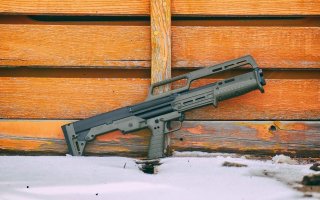Meet Kel-Tec's Five Deadliest Guns
Kel-Tec is one of the most polarizing companies in the American gun industry, known for making exotic designs at cheap prices.
But the other aspects of the Sub 2000 fell behind. The original Sub 2000 lacked any provision to mount accessories. Kel-Tec remedied this in their second-generation of the gun, which features an M-LOK rail and Picatinny upper handguard. But optics still are not readily mountable on the Sub 2000 due to the folding nature of the gun. Any optics placed on the upper handguard prevent the rifle from folding, eliminating the one unique aspect of its design.
The shooting characteristics, while not bad, also fell behind the latest generation of PCCs. The Sub 2000 is a simple blowback firearm, where a heavy bolt moves back and forth under the recoil of a cartridge, with no locking mechanism. This can result in substantial felt recoil, notably the Colt 9mm SMG, another 9mm simple blowback firearm is said to have similar recoil to the full-size M16, despite the M16 cartridge being far more powerful.
Modern PCCs take some steps to mitigate this. Some designs, like semi-auto versions of the MP5, CMMG’s Banshee, or Sig Sauer’s MPX use various delayed blowback or locking systems to lighten the weight of the bolt and decrease its velocity. Other designs like PSA’s AK-V, Grand Power’s Stribog, or B&T’s various PCCs use a weighted or hydraulic buffer to slow the rearward motion of the bolt down.
The Sub 2000 doesn’t use any of these systems, and thus features a worse recoil impulse than many other modern PCCs. While it may still be the best gun for the job if you need a 16-inch barrel and also a compact form factor, other new PCCs are as compact or more so and feature better ergonomics and shootability.
Kel-Tec KS7:
In the summer of 2019, Kel-Tec released their KS7, a stripped-down version of their earlier KSG. Featuring a single magazine tube and an integrated carry handle, the KS7 is cheaper, slimmer, and lighter than its larger cousin. But in shedding the additional magazine tube, does the KS7 become a better or worse gun?
According to Kel-Tec themselves, the KS7 was built to ergonomically improve upon the KSG. This is pretty evident in the design of the pump itself, unlike the original flat surface of the KSG, the KS7 features a prominent flare at the front of the handle to prevent the hand from slipping in front of the barrel.
The single-tube also improves the ergonomics of the shotgun’s reload. While still kind of awkward due to the position in the rear of the stock, the narrower chute resembles traditional shotgun designs and is far easier to load shells into than the wide opening meant to feed both tubes in the KSG.
Kel-Tec also said that they wanted the shotgun to be ready to go “out of the box” unlike the KSG, which didn’t come with iron sights and only had a top Picatinny rail. They saw the carry handle as an easy way to add integrated sights to the shotgun.
This can be seen as a hit and a miss. While it’s good to include sights out of the box, and the integrated carry handle sight might be enough for most shooters, most advanced users will likely replace it with a Picatinny rail, which negates the “carry” benefit of the carry handle. Kel-Tec likely decided to go with building the handle as a separate module instead of a Picatinny attachment that fits right on the rail to add balance and reduce manufacturing cost, but it is one that the customer must field in the end. Also, the KS7 doesn’t feature a Picatinny rail under the grip, if one prefers to use a vertical grip for additional safety when racking the shotgun.
The KS7 also incorporates a variety of M-LOK slots all over the shotgun for the mounting of various accessories, a welcome modernization from the mostly Picatinny attachment KSG.
Altogether, these changes and the affordable MSRP of only $500 (which will likely translate into a street price of $400) means that the KS7 is a decent shotgun to mess around with if one wants a compact bullpup with futuristic looks.
However, conventional shotguns are still probably better for most consumers. The ability to rapidly load a shell through the side ejection port is something that the KS7 doesn’t provide with its bullpup layout, and that capability is one of the things that makes shotguns unique and useful.
All in all, the KS7 is probably one of the best bullpup shotguns on the market. But bullpup shotguns are incredibly niche because they aren’t all that useful in the end. Conventional shotguns dominate the hunting, sporting, and tactical use cases, and the KS7 is unlikely to change that.
Charlie Gao studied political and computer science at Grinnell College and is a frequent commentator on defense and national-security issues. This article originally appeared as multiple articles and is being packaged together for reader's convenience.
Image: Kel-Tec


